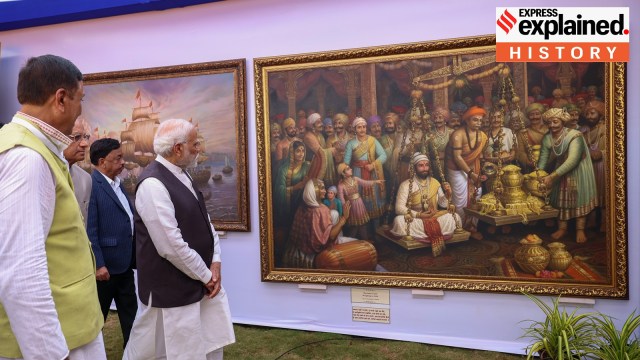Navy Day: As PM Modi praises Shivaji’s naval prowess, a look at the Maratha Navy
Navy Day 2023: Chhatrapati Shivaji Maharaj very much understood the importance of building a naval force. Here is what you need to know about the Maratha Navy he built from scratch.
 Prime Minister Narendra Modi admiring a painting of Chhatrapati Shivaji Maharaj at Sindugarh Fort yesterday. (Twitter/@narendramodi)
Prime Minister Narendra Modi admiring a painting of Chhatrapati Shivaji Maharaj at Sindugarh Fort yesterday. (Twitter/@narendramodi)Prime Minister Narendra Modi, on the occasion of Navy Day (December 4), paid tributes to Chhatrapati Shivaji Maharaj, and unveiled a grand statue of the 17th century Maratha king at the coastal fort of Sindhugarh, Maharashtra.
PM Modi noted that Shivaji knew the importance of naval power, and announced that epaulettes (ornamental shoulder pieces denoting rank) adorned by naval officers will soon carry his emblem. Last year, at the commissioning of aircraft carrier INS Vikrant in Kochi, the PM had unveiled the Indian Navy’s new Ensign (flag) based on the seal of Shivaji.
We take a look at the Navy of Chhatrapati Shivaji Maharaj, which, as PM Modi said last year, “gave his enemies sleepless nights.”
Marathas and Indian Navy
The Indian Navy has always acknowledged the sea-faring prowess of the Marathas, under Shivaji and later. It has named its training establishment in Lonavla as INS Shivaji, and the shore-based logistics and administrative hub of the Western Naval Command, Mumbai, as INS Angre — after Kanhoji Angre (1669-1729), the celebrated Maratha naval commander.
The use of the octagonal design of the seal of Shivaji on the new Naval Ensign simply furthered this connection. As an Indian Navy document noted: “Shivaji realised the importance of having a secure coastline and protecting the western Konkan coastline from the attacks of Siddis’ [Afro-Indians allied with Deccani Sultans] fleet”.
Shivaji’s navy
Shivaji’s empire reached the west coast after 1656-57, when his dominions touched Kalyan. In the same year, he decided to establish a navy in order to protect his territory from the Siddis, and secure ports and merchant ships which would ensure maritime trading, that brought in revenue and customs duty, went on smoothly. His vision for establishing a naval wing of his military was based on his belief in ‘Jalameva yasya, balameva tasya’ (‘He who rules the seas is all powerful’)
Between 1661 and 1663, the Maratha Navy came into existence, and at its peak included 400-odd ships of various kinds and sizes. These included both larger battleships, and other vessels of varying shapes and purposes, such as the gurab, tarande, galbat, shibad, and pal.
According to BK Apte’s pioneering A History of the Maratha Navy and Merchant Ships (1973), Shivaji’s navy tasted its first success when he used 85 ships to attack Basuru near Kundapura in today’s Karnataka — a mission which yielded a huge booty.
Between 1653 and 1680, Shivaji ordered the construction of multiple naval forts, starting with the Vijaydurg in 1653, and followed by the likes of Sindhudurg and Kolaba.
These forts, many of them unconquered, were used for strategic purposes, to keep a watch on enemies approaching via the seas. North Konkan’s Kalyan and Bhivandi, which were part of the Bijapur territory, came under Shivaji’s control by 1657. Even after Shivaji’s demise, the Maratha Navy continued to be a formidable force, led by admirals such as Angre.
The limitations of this Navy
While Shivaji showed incredible military acumen in developing a naval force, its strategic objectives remained limited “to counter and, possibly, pre-empt the marauding Siddis [of Janjira] adept at projecting power on land from their sea bases”, historians Anirudh Deshpande and Muphid Mujawar wrote in their book on the Maratha Navy, The Rise and Fall of a Brown Water Navy (2021).
The Marathas, thus, never really challenged European naval power in the high seas. While they could hold their own in littoral waters, Maratha merchant vessels heading towards West Asia, just like any other merchant ship at the time, paid a special tax to the Portuguese, the preeminent maritime power of Shivaji’s time.
After the decline of Portuguese power, the control of the high seas went to the British, and the Royal Navy, credited by many historians as being the basis on which the British built their empire. The Marathas, unfortunately, did not have the means to compete with these blue water behemoths of the time.
This is an edited and updated version of an explainer published on September 3, 2022.
- 01
- 02
- 03
- 04
- 05






































